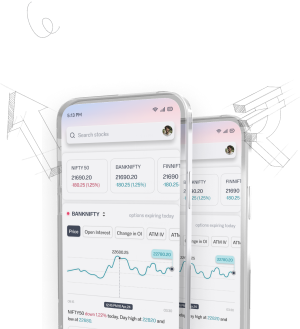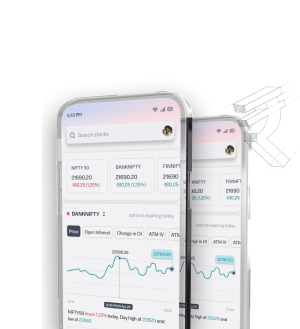Gravestone Doji: Explaining An Important Candlestick Pattern
Gravestone Doji is one of the rare but important candlestick patterns. This pattern will tell how there might be a possible bearish reversal pattern. It looks like a cross and occurs after a rise in prices, thereby depicting a change in the market mood.
This pattern has a long upper shadow and almost no lower shadow. It shows selling pressure is growing and upward moves are getting difficult.
The knowledge of the Gravestone Doji allows the trader to make better decisions in terms of timing. That is, one will know when to sell or buy. That is if you see a Gravestone Doji, prices may go low. With apps like Sahi Trading, this means we can react fast on such signals for trading.
What is a Gravestone Doji?
The Gravestone Doji is a pivotal candlestick pattern in technical analysis. It is typically a signal that can be an indication of a potential reversal of the trend and appears on the last bars of an uptrend. The information on it could be very useful in completing our trading strategy.
Origin and Definition
Gravestone Doji is one of the Japanese Candlestick charting patterns. This means that there is some form of indecision in the market. The open and close prices are very close to each other and nearly reach the level of the session low.
This very minor swing of price is a struggle of the buyers to the sellers. The sellers are the winner at the end of trading.
Common Feature of the Chart
- Gravestone Doji features of a big upper shadow with the lower shadow being quite short.
- It acts as a reversal pattern at the top of a rise.
- It indicates a bearish mood that indicates change in trend.
- It is often complemented with other tools for the confirmation of a signal.
We should not overreact for just the sake of the Gravestone Doji. There are just so many lessons to learn from this specific candle in a candlestick chart. Still, other indicators must be checked, especially with a bigger market picture.
Formation of the Gravestone Doji
To understand the Gravestone Doji, the analysis would not be complete without the previous price action leading up to it and general market sentiment upon appearance. Detailed analysis of these aspects allows a person to understand why this bearish sign is important.
Price Action Leading to Formation
The Gravestone Doji follows a period wherein buyers push prices up significantly. That is depicted in this stick by a long upper shadow. It points out the unwillingness of the buyers to let the price decline.
Whenever prices reach new heights, the sellers start resisting. This is visible when the candle closes nearly at or near the location at which it started with a minor or no lower shadow. This generally indicates a flip from rising prices to a strong rejection and, therefore, bears do feel.
Formation Market Sentiment
Market sentiment is the key in making a Gravestone Doji. All are bulls initially then comes bears. This is a huge change showing that traders have uncertainty.
As the prices fall back to the starting point, it means the market is becoming bearish. And this confusion of emotions all within one trading day sums it all up. And that's what makes us think of changing our trades because of a possible trend reversal from a selling pressure that is much stronger than the buying forces.
| Attribute | Explanation |
|---|---|
| Price Action | It initiated in an upward movement, but the bulls were rejected at higher levels. |
| Market Sentiment | It's like from having confidence in the bullishness to being uncertain and bearish. |
| Candlestick Features | Long upper shadow, short or nonexistent lower shadow, very small real body |
| Implication | Possible bearish reversal following an important trend upward |
The Interpretation of the Gravestone Doji
The Gravestone Doji is important in giving negative signals after an uptrend. It warns us about a possible change in the price. After its formation, the market can start moving in a bearish direction.
How to Determine Negative Reversal Indicators
This pattern signifies a massive decline in purchasing power. When we see the Gravestone Doji, it means sellers are in the lead. It looks like a thin line because the opening and closing prices are almost equal to each other.
It reminds us to reevaluate our trades. It is an appropriate time to short-sell, but we have to check some other indicators as well. This helps us cut down losses.
Importance in Technical Analysis
Gravestone Doji is very significant in technical analysis. This can often be seen along with other bearish signs. Here, we are using it together with tools like RSI or MACD in order to be able to confirm it.
But we cannot depend on it only. It shows the fight of the buyer with the seller. So we have to research much and put many indicators into the process in order to have the best trades.
Identifying the Gravestone Doji Pattern
The Gravestone Doji pattern can be seen with strong focus on specific characteristics. It's a key signal in our systems to indicate when price may start falling. With proper knowledge on its identification, it helps us improve our trading signals.
Critical Characteristics
The Gravestone Doji has specific features that distinguish it from other patterns:
- Long Upper Shadow: This shadow is way more significant compared to the body. This indicates that the buyers were attempting to drive the price high.
- Minimum Lower Shadow: The lower shadow is very small or it's negligible, and it points to strong bearish feelings.
- Open and Close Prices: Opening and closing prices will be nearly the same thing, meaning the body will be thin.
Such signals suggest a loss of purchasing power within an uptrend. Note how such features tend to coincide with points of resistance. This can, in itself, confirm the bearish signals we find.
Background Conditions for Validity
To enhance the possibility of easier recognition of the Gravestone Doji, let us consider the background market conditions:
- Rising After an Uptrend: Discover if the pattern occurs after a strong uptrend.
- Nearest Support and Resistance Level: Its proximity to key levels can add strength to the bearish signals.
- Support from Technical Indicators: Moving averages or oscillators would verify the trade.
We can then view the candlesticks after the Gravestone Doji to see if the market is continuing or reversing. That's pretty big for our trading plan, because we can then use bearish momentum divergences, as well as other bearish structures. We will be able to execute our trade and gain some decent rewards with minimal risks by identifying these aspects.
| Characteristic | Description |
|---|---|
| Upper Shadow | Long means there is heavy selling pressure |
| Lower Shadow | Either minimal or non-existent |
| Body | Short; that's, open and closing prices are almost the same |
| Trend Context | Part of a bullish trend, usually at resistance |
| Confirmation | Following bearish candles makes the signal even more compelling |
Trading the Gravestone Doji Succesfully
It means we will trade the Gravestone Doji according to the best entry ways and strong risk management. The bearish reversal pattern could really enhance our trading plan if we spot the sure signs before trading. We should wait for the sure signals that come from the next candlestick or other signals that show some big drop.
This careful step avoids false signals and makes the choices we make in trading stronger.
Best Practices to Enter Trades
The signal of a Gravestone Doji is a reason for caution. Here are some good practices to follow:
- Wait for confirmation from the next candlestick, preferably in the form of a bearish movement.
- Use extra indicators like Relative Strength Index (RSI) to aid your analysis.
- Consider the overall market conditions and confirm if the pattern forms at the key resistance levels.
Risk Management Techniques
Good risk management is the secret to trading the Gravestone Doji. Here are some strategies to consider:
- Set your stop-loss orders just above the high of the Gravestone Doji to minimize loss.
- Find potential target levels based on past support and resistance, while ensuring our risk-reward ratio is good
- Be continuing to monitor the market, aware of news or events which may cause price to shift.
These techniques will make better trades and manage risk well. Gravestone Doji is a strong trading signal. It produces better outcomes when we apply the right tools of risk management, and staying alert to the changes in the market as well.
Gravestone Doji vs. Other Doji Patterns
Different doji patterns make smart trading decisions. Here, each type of doji pattern plays its unique role in showing the conditions of the market. The Gravestone Doji and Dragonfly Doji are special because they mean opposite things for traders.
Comparison to Dragonfly Doji
The Gravestone Doji appears during the end of a trend and may represent a bearish signal. It indicates that buyers attempted to push prices higher but were unable to do so, turning the control back to sellers, thus close price near where it opened.
The Dragonfly Doji, though, gives a bullish signal that occurs after a downtrend. It is the case when sellers try to push prices lower, but buyers respond by causing prices to move up nearly all the way to the starting point. That would be a sign of a potential trend reversal.
- Gravestone Doji: Possible bearish reversal at market highs.
- Dragonfly Doji: Possible bullish reversal at market lows.
Other Candlestick Patterns to Consider
Other major candlestick patterns include other doji patterns. The Long-Legged Doji indicates that the market indecision has long wicks, which means high volatility. The Neutral Doji signifies balance, whereby the opening and closing prices are almost the same. This tells us that the market is confused about its direction.
Each doji pattern gives us varied insight into what the market is feeling:
| Candlestick Pattern | Market Context | Indicator Type |
|---|---|---|
| Gravestone Doji | End of uptrend, rejection of higher prices | Bearish Indicator |
| Dragonfly Doji | Inability of the market to break the prices lower | Bullish Signal |
| Long-Legged Doji | Uncertainty due to extreme volatility | Market Indecision |
| Neutral Doji | Buyers and sellers are at the same level | Market Indecision |
Using all the different doji formations along with their signals we add credibility to our analysis. This is then helpful for finding even the positive bearish and bull signs so that we make a smart choice in trading.
Weaknesses of the Gravestone Doji
The trader must define the limit of the Gravestone Doji. That pattern actually indicates a cue for the reversal; in fact, it might be misleading. Therefore, let's understand it with the general market trend.
Common Misconceptions
Gravestone Doji is mostly misunderstood by traders. It appears after a long uptrend, which says that some thing has changed. But do not forget trends and general mood of the market either. If we neglect those factors, we can be stuck with the bad trades.
Importance of Market Context
Market state is crucial when using the Gravestone Doji. The trends and forces of the market should then be considered. In an uptrend, the appearance of a Gravestone Doji may indicate reversal, but not until volume checks are done or bearish candles have appeared.
We would also be wise to place stop-loss above the Gravestone Doji. We now know more about candlestick patterns than we did before having adjusted our approach according to the current market.
Volume Analysis with Gravestone Doji
Adding volume analysis to our trading plan can really drive how well we understand the Gravestone Doji. In the following scenarios, looking at volume gives us a bit of insight as to what we should expect: If this pattern occurs with high volume, there has been plenty of market action going on and tends to favor a bearish turn.
How to Understand Volume Confirmation
Volume verification is important so that our Gravestone Doji has a signal that is real. Strong volume levels often suggest some level of interest by the market participants, and this makes the bearish signal from the gravedigger even more reliable, thus helping us avoid false signals.
Market Participation Evaluation
Well, it's of great importance to know the part the market plays concerning the Gravestone Doji. High volume, indeed, will mean a great deal of trading activity, hence a change in sentiment. But low volume will raise so many doubts in our minds. However, by looking into the details, we can make better trading choices.
| Level of Volume | Change in Market Sentiment | Validation of Trading Signals |
|---|---|---|
| Volume High | Strong Bearish Significance | Highly Increased |
| Volume is Average | Chances of Bearish Signals | Lies Beyond Moderate Validity |
| Volume Low | Uncertainty of Sentiment | Effects on Trading Validating is Decreased in Value |
Using volume analysis helps make our trades better match real market action. This ensures that we capture strong trading signals far more often than we normally would. Our strategies get more powerful and flexible.
Trading Examples of Gravestone Doji
Great insights come from real-life market scenarios with Gravestone Doji. For example, recent downtrends of tech stocks saw this bearish pattern appear after a strong uptrend. The long upper shadow indicated that the buyers faced strong sellers, and thus the prices dropped.
This explains how the Gravestone Doji might signal that something may change and even urge traders to change their approach.
Real-Life Market Scenarios
Thus, by the study of price action, we can see that the Gravestone Doji most of the time marks huge changes in the mood of the market. So, it occurred during seasonal changes in the stock market after a huge rise. It warned us that the bullish trend was weakening.
This is what the value of catching this pattern before we go trading even more teaches us. This would help to treat the ups and downs of the market better and improve our tactics.
Lessons from Historical Price Action
From previous price actions, we learn that the Gravestone Doji is even more useful when used together with other indicators. If we use the pattern with volume levels, we can be able to understand the strength of a potential decline. For example, higher trading volumes with the Gravestone Doji confirm its bearish signal.
This teaches us that the market analysis is complex and needs a complete approach. We must make use of all the tools that are at our disposal when trading.
FAQ
What does the Gravestone Doji signify in trading?
The Gravestone Doji signifies a bearish reversal following an uptrend. It means the sellers are in control after the buyers first push up the price.
How to confirm the formation of a Gravestone Doji?
You must verify its existence upon a major rally before you are going to trade. Furthermore, you must scan the background, and there must also be some other indication or volume to validate before you trade.
What are the primary characteristics of Gravestone Doji?
Gravestone Doji consists of a long upper shadow and a short lower shadow. This indicates the open and close prices nearly equal. Usually, it implies the buying strength is weak, and the sellers may enter now.
How does it show volume? Volume and the Gravestone Doji
Key point: The main thing is volume using the Gravestone Doji. High trading volume makes the bearish signal stronger. It allows us to know if it's a real signal.
Limitations using only the Gravestone Doji
We can get false signals using only the Gravestone Doji. A view of the broader market picture is needed, as well as other signs. This prevents mistakes.
How is the Gravestone Doji different from other doji formations?
The Gravestone Doji is a warning of a bearish reversal after an uptrend. The Dragonfly Doji hints at bullish chances after a downtrend. They show different market moods.
What are the best practices that we should follow in trading the Gravestone Doji?
Wait for more information before trading with the Gravestone Doji. Proper risk management means placing your stop-loss orders at the high of the doji.
Does Sahi Trading App enable trading the Gravestone Doji?
In fact, yes. Sahi Trading App aids us in taking swift actions based on Gravestone Doji. It makes trading faster and easier in all ways.
You may also like blogs on the topic:
Disclaimer
The content provided is for educational purposes only and does not constitute financial advice. For full details, refer to the disclaimer document.




